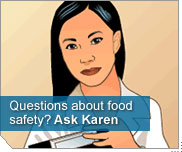 |
|
| Food Safety: Foodborne Illness |

What is foodborne illness, and
what are the symptoms?
Foodborne illness often presents itself as flu-like symptoms such
as nausea, vomiting, diarrhea, or fever, so many people may not recognize
the illness is caused by bacteria or other pathogens in food.
Thousands of types of bacteria are naturally present in our environment.
Not all bacteria cause disease in humans. For example, some bacteria
are used beneficially in making cheese and yogurt.
Bacteria that cause disease are called pathogens. When certain pathogens
enter the food supply, they can cause foodborne illness. Millions
of cases of foodborne illness occur each year. Most cases of foodborne
illness can be prevented. Proper cooking or processing of food destroys
bacteria.
Age and physical condition place some persons at higher risk than
others, no matter what type of bacteria is implicated. Very young
children, pregnant women, the elderly and people with compromised
immune systems are at greatest risk from any pathogen. Some persons
may become ill after ingesting only a few harmful bacteria; others
may remain symptom free after ingesting thousands.
(Source: Foodborne
Illness: What Consumers Need To Know)
How can I prevent foodborne illness?
There are four basic steps to follow:
- Clean: Wash hands and surfaces often
- Separate: Don't cross-contaminate
- Cook: Cook to proper temperatures
- Chill: Refrigerate promptly
For more information, see this Web site for Fact Sheets such as Basics
for Handling Food Safely. The Centers for Disease Control and
Prevention (CDC) has information available at www.cdc.gov/foodsafety.
Or, visit the Partnership for Food Safety Education Web site at www.fightbac.org.
(Source: Basics
for Handling Food Safely)
Is it safe to eat lightly cooked
egg dishes, or use recipes that call for raw eggs?
Today some unbroken fresh shell eggs may contain certain bacteria
that can cause foodborne illness. The bacteria are Salmonella
enteritidis. While the number of eggs affected is quite small,
there have been some scattered outbreaks in the last few years. Currently
the government, the egg industry and the scientific community are
working together to solve the problem.
Researchers say that if present, the Salmonella bacteria
are usually in the yolk or "yellow." But they can't rule out the bacteria
being in egg whites. So everyone is advised against eating raw or
undercooked egg yolks, whites or products containing them.
People with health problems, the very young, the elderly and pregnant
women (the risk is to the unborn child) are particularly vulnerable
to Salmonella enteritidis infections. A chronic illness weakens
the immune system making the person vulnerable to foodborne illnesses.
(Source: Shell Eggs from Farm to Table)
Is it dangerous to eat raw or
"rare" ground beef?
Yes. Raw meat may contain harmful bacteria. USDA recommends not eating
or tasting raw or undercooked ground beef. To be sure all bacteria
are destroyed, cook meat loaf, meat balls, casseroles, and hamburgers
to 160 °F. Use a meat thermometer to assure proper degree of doneness.
Think about this... 1 out of every 4 hamburgers turns brown in the
middle BEFORE it has reached a safe internal temperature, according
to USDA research.
(Sources: Focus
on Ground Beef; Use
A Food Thermometer)
Is it safe to eat moldy cheese
or salami if I cut away the mold? What about fruit, jelly, or bread?
Some molds are used to make certain kinds of cheeses including Roquefort,
blue, Gorgonzola, Stilton, Camembert, and Brie. The mold on these
cheeses is safe to eat. Mold on other types of cheeses should not
be there. Discard any soft cheese showing mold. For hard cheese, such
as Cheddar, cut off at least 1-inch around and below the mold spot
(keep the knife out of the mold itself). After trimming off the mold,
the remaining cheese should be safe to eat. Re-cover the cheese in
fresh wrap and keep refrigerated.
Do not buy or use moldy meats. Fresh meat and poultry are usually
mold free, but cured meats and smoked turkey may not be. Examine them
carefully. Exceptions: Some salamis–San Francisco, Italian and
Eastern European types–have a characteristic thin, white mold
coating. they shouldn't show any other mold. Dry-cured country hams
have surface mold that must be scrubbed off before cooking.
Discard any soft fruits or vegetables, jams and jellies, bread, and
baked goods that show signs of mold.
(Source: Molds
on Food: Are They Dangerous?) |
Last Modified:
August 15, 2006 |
|
|
|
 |
 |

|

|
|

|

|
 |
FSIS Advertisement Rotator

|
|
|